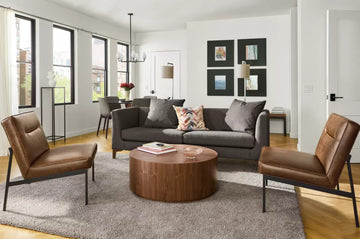When it comes to furnishing or decorating a home, there’s one material that seems to speak the universal language of warmth, character, and timelessness—wood. Whether you’re into minimal, Scandinavian-inspired interiors or lean more toward cozy, rustic charm, wood plays a central role in shaping the mood of a space.
But beyond just picking “something wooden,” lies a deeper layer of choice—one that involves grain, tone, and texture. These aren’t just aesthetic details; they’re the heartbeat of your home’s style.
Let’s walk through this rich world of wood together—no jargon, no fluff. Just useful, practical insight to help you make smart, beautiful choices for your space.
🌲 Why the Wood You Choose Matters More Than You Think
Choosing the right wood is kind of like choosing the right music for a dinner party. It sets the tone, speaks to your personality, and subtly influences how people feel in your home. Each type of wood has a unique story—told through its grain, whispered through its tone, and felt in its texture.
Whether you're curating a living room that's light and breezy or a reading nook that's warm and cocooning, the wood you select is essential to the mood you’re crafting.

🌿 1. The Grain Game: Understanding Wood Patterns
Grain refers to the pattern you see in a cut of wood—those natural lines, swirls, and whorls created by growth rings. These aren’t just beautiful; they’re deeply expressive.
Here’s a quick breakdown of grain types:
Straight Grain: Uniform, tidy lines that run in one direction. Great for clean, minimal designs.
Wavy or Curly Grain: Adds movement and softness, often used in statement pieces.
Knotted Grain: Brings rustic charm and a sense of natural imperfection. Perfect for farmhouse-style homes or reclaimed wood pieces.
Want a piece that hints at history and character? Something like the Rustic Side Table made from Reclaimed Wood fits beautifully. Its rich grain variation gives it that one-of-a-kind personality you just can’t fake.
🎨 2. Tone: The Mood of the Wood
Tone is all about color—from pale ash blonde to deep, dark espresso.
Here are a few tones and their personalities:
Light Woods (e.g., Oak-ish, Ash): Open, airy, perfect for smaller spaces. Think Scandi-cozy.
Medium Woods (e.g., Chestnut, Walnut): Versatile and warm. They pair beautifully with neutrals and pops of color.
Dark Woods (e.g., Mahogany, Teak): Dramatic, luxe, and ideal for adding depth to a room.
For instance, the Chestnut London Media Unit offers a stunning balance of rich mid-tone chestnut wood that blends well with both modern and vintage décor. It’s bold without overpowering.
Pro tip: Mix tones if you're feeling adventurous! Just make sure there's a common undertone (like a warm base) to tie everything together.
👋 3. Texture Talks: Feel the Difference
Texture is often overlooked, but it's what makes wood feel real. Glossy woods can appear sleek and modern, while rough-hewn or matte finishes create a tactile, grounded feel.
Popular textures include:
Smooth/Sanded: Great for polished interiors. Often used in contemporary designs.
Distressed/Reclaimed: Rich in story and texture. Offers a rustic, lived-in feel.
Live Edge or Rough-Cut: For a bold, naturalistic statement—like the tree is still telling its tale.
If you love a bit of raw charm, consider incorporating reclaimed scaffold board shelves—they’re practical, textural, and a great way to introduce rough, earthy notes into your home without overwhelming the space.
🏡 Bringing It All Together: Wood in Every Room
Wood can work its magic in every corner of your home:
Living Room: A coffee table with visible knots and a warm tone makes a cozy centerpiece.
Bedroom: Go for bedside tables with soft curves and subtle grains for a calming effect.
Kitchen: Open shelving made from reclaimed wood adds both warmth and functionality.
Hallway or Entry: Console tables in dark-toned wood make a bold first impression.
And if you're furnishing a smaller space? Choose multi-functional pieces with clean grains and lighter tones to keep things feeling open and bright.
💡 Quick Tips for Choosing the Right Wood for Your Home
Match wood grain to your style. Clean and straight for modern, varied and rough for rustic.
Use tone to set the mood. Light = open; dark = dramatic; mid-tone = cozy and classic.
Don’t forget the finish. Matte and distressed are great for a relaxed look; gloss suits modern spaces.
Mix—but don’t clash. Use similar undertones when combining different woods.
Let the wood lead. If you fall in love with a piece, design around it. Wood often knows best.
✨ Conclusion: Let Wood Tell Your Home’s Story
Choosing the right wood is like choosing the right words for a love letter—it matters. Wood isn’t just a material; it’s a narrator of warmth, history, and authenticity. From the rich ribboned grain of reclaimed boards to the smooth elegance of polished chestnut, each type tells its own quiet tale.
So next time you’re browsing furniture or planning a room refresh, take a moment to really see the wood. Run your fingers across its texture. Notice its tones. Imagine how it will catch the morning light or reflect the soft hum of evening lamps.
Because when you choose the right wood, you’re not just decorating a space. You’re curating an experience—one that feels honest, grounded, and beautifully yours.






